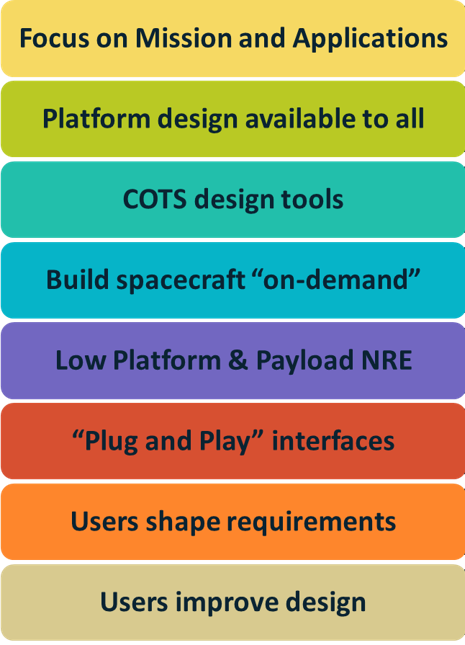Changing space industry paradigms with the Open Source Satellite Programme
Taking The Leap From Earth To Space
There are some in the industry who are sceptical that an open source satellite, that provides mission utility at an affordable price can be achieved and that there won’t be sufficient interest or demand to make this business model work sustainably.
However, if one were to look back at the history of space and related areas of technology and capability it is clear that no-one can fully predict where the future will take us. For example, the first iPhone was released in June 2007 and no-one could have envisaged the imagination that it would stimulate and the opportunities that it would create.
The aim is to use the Open Source Satellite philosophy to open peoples' minds to new possibilities about what can be achieved if the affordability-accessibility paradigm could be changed for space missions, in the same way that it is being achieved in terrestrial applications.
This is why the Open Source approach is particularly appealing. The key traits are that, because it is driven by the sections of the community that have an interest, the requirements, as well as the knowledge and capabilities that are required, can organically be drawn together from a team of global participants, suppliers and customers.
The Open Source Satellite Programme: Promoting end-to-end mission affordability
All of these considerations can be distilled into an overarching business case need for end-to-end mission affordability in low manufacturing quantities. There are several factors that influence affordability that we will be implementing in the Open Source Satellite platform design and programmatics:

Focus on Missions and Applications
The Satellite Platform provides Mission Support. The sole purpose of the Satellite Platform is to provide the resources that are needed to support the mission. Therefore there needs to be a focus on reducing the mass, power and accommodation requirements of all of the platform subsystems.
The Platform is not the Mission; the Platform enables the mission to be implemented - and the element that enables each specific mission and which delivers value to the end customer is the Payload.
Taking a "clean sheet” approach to considering the entire end-to-end mission problem space is leading to the creation of a microsatellite platform that is modular and scalable, and not costly to adapt, build and operate for different missions.
Platform Design Available To All
The designs and the build instructions will be made available to all; teams can build their own platform. Allowing teams to take and use the Open Source Satellite Platform design accelerates time to launch and mission operations and allows mission teams to focus on their unique mission and business, rather than the platform “infrastructure”.
Strategic partners and sponsors gain early access to designs, giving them time to leverage the know-how before general release.
COTS Design Tools
Costly proprietary design tools create barriers to entry; tools need to be easy to access and affordable, to maximise the number of teams who are able to utilise the Open Source Satellite Programme designs.
Increasing the use of low-cost or open-source design tools will allow more people to access and use the designs and either use them as they are, or tailor the designs as necessary.
Building Spacecraft "On-Demand"
The Open Source Satellite is being designed to be stable, flexible and capable of meeting the operational requirements of a wide range of different missions in order to support a "Build On-Demand" approach. This allows the spacecraft production to align with project schedules and allows teams to retain overall programmatic control, without the need to invest in costly high-volume manufacturing capabilities and supply chains.
Low Platform And Payload Non-Recurring Engineering Costs
A high level of baseline platform performance enables the delivery of commercially-viable and sustainable solutions and missions. The provision of a stable, capable baseline for current and subsequent missions reduces the risk of nugatory work and NRE (Non-Recurring Engineering costs). The platform is being designed to be able to integrate scalable peripherals such as actuators, and power generation subsystems, for example, for missions requiring increased agility or power.
"Plug-And-Play" Interfaces
The Open Source Satellite Platform provides a clear platform-payload delineation. This allows payload developments to progress independently of the platform development and also provides a clear set of interfaces and design envelopes for payload designers to use, both contributing to improve schedule efficiencies and project costs.
A key objective of the open source satellite programme is to take out as much labour and “touch time” as possible out of every project. This logically drives the approach of bringing as much of the generic functional architecture into the platform. The goal is to get to the point where only the things that change from mission to mission will sit outside the platform boundary, to support a “plug and play” approach to payload and mission integration and simpler interfaces. The "plug-and-play" approach also extends to ground interfaces.
Users Shape Requirements
As discussed, the Stakeholder Needs and Perspectives drive the requirements envelope and the solution. In order to ensure that the design satisfies current, mid-term and future needs, the Team's continuous evaluation of Market demands and emerging technologies also have an important influence on the future roadmap strategy.
Users Improve Design
The Open Source mindset requires that Intellectual Property is released “out into the wild” for teams to use and adapt freely. Creating an ecosystem which serves the Community creates ample opportunities for the Community to contribute back into the programme, to improve the design and to ensure platform and process utility.
What other factors have an impact on mission affordability? Let us know in the Comments section below.
www.opensourcesatellite.org exists to create an environment that supports and enables entrepreneurial and innovative thinking, with the aim of taking the next step in small satellite capabilities.
Join our Community, Follow us and be part of the journey!
COMMENT
Thank you for your comment